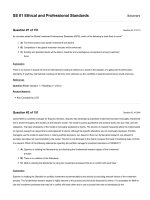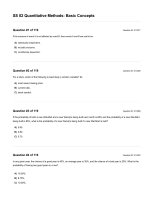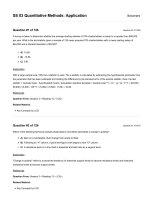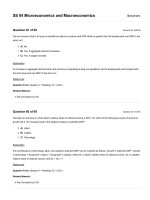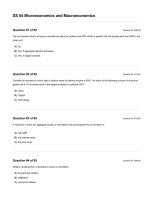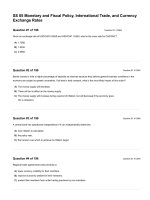CFA 2019 level 1 schwesernotes book quiz bank SS 05
Bạn đang xem bản rút gọn của tài liệu. Xem và tải ngay bản đầy đủ của tài liệu tại đây (566.67 KB, 49 trang )
SS 05 Monetary and Fiscal Policy, International Trade, and Currency
Exchange Rates
Question #1 of 196
Question ID: 413964
Given an exchange rate of USD/CAD 0.9250 and USD/CHF 1.6250, what is the cross rate for CAD/CHF?
A) 1.7568.
B) 1.5032.
C) 0.5692.
Question #2 of 196
Question ID: 413842
Banks choose to hold a higher percentage of deposits as reserves because they believe general business conditions in the
economy are subject to greater uncertainty. If all else is held constant, what is the most likely impact of this action?
A) The money supply will decrease.
B) There will be no effect on the money supply.
C) The money supply will increase during a period of inflation, but will decrease if the economy goes
into a recession.
Question #3 of 196
Question ID: 413868
A central bank has operational independence if it can independently determine:
A) how inflation is calculated.
B) the policy rate.
C) the horizon over which to achieve its inflation target.
Question #4 of 196
Regional trade agreements exist primarily to:
A) lower currency volatility for their members.
B) improve economic welfare for their members.
C) protect their members from unfair trading practices by non-members.
Question ID: 413934
Question #5 of 196
Question ID: 413936
Which of the following lists of trading blocs is most accurately ordered by degree of economic integration, from least to most
integrated?
A) Free trade area, common market, customs union.
B) Customs union, economic union, monetary union.
C) Free trade area, economic union, common market.
Question #6 of 196
Question ID: 413851
Which of the following statements about the demand and supply of money is most accurate? People who are:
A) holding money when interest rates are lower will try to increase their money balances and, as a result, the
supply of money increases.
B) holding money when interest rates are higher will try to reduce their money balances and, as a result, the
demand for money decreases.
C) buying bonds to reduce their money balances will increase the demand for bonds with an associated
increase in interest rates.
Question #7 of 196
Question ID: 413900
The government budget deficit of Country M is increasing. At the same time, the government budget surplus of Country N is
decreasing. Are the fiscal policies of these countries expansionary or contractionary?
A) Both are expansionary.
B) Both are contractionary.
C) One is expansionary and one is contractionary.
Question #8 of 196
The primary benefits derived from tariffs usually accrue to:
A) foreign producers of goods protected by tariffs.
B) domestic suppliers of goods protected by tariffs.
C) domestic producers of export goods.
Question ID: 413928
Question #9 of 196
Question ID: 413952
An exchange rate at which two parties agree to trade a specific amount of one currency for another a year from today is called a:
A) spot exchange rate.
B) forward exchange rate.
C) real exchange rate.
Question #10 of 196
Question ID: 434265
Country G and Country H have currencies that trade freely and have markets for forward currency contracts. If Country G has an
interest rate greater than that of Country H, the no-arbitrage forward G/H exchange rate is:
A) greater than the G/H spot rate.
B) less than the G/H spot rate.
C) equal to the G/H spot rate.
Question #11 of 196
Question ID: 413988
The tendency for currency depreciation to increase a country's trade deficit in the short run is known as the:
A) absorption effect.
B) Marshall-Lerner effect.
C) J-curve effect.
Question #12 of 196
The term "automatic stabilizers" refers to:
A) changes in taxes and expenditure programs legislators automatically enact in response to changes
the level of economic activity in order to smooth economic cycles.
B) government expenditures and tax receipts that are required to balance over the course of the
business cycle, although they may be out of balance in any single year.
C) increases in transfer payments and decreases in tax revenues that result from an economic
contraction without new legislation.
Question ID: 696228
Question #13 of 196
Question ID: 413923
Which of the items below is NOT a valid reason why nations adopt trade restrictions? To:
A) prohibit foreign firms from increasing market share by selling products below cost.
B) protect industries in which they have a comparative advantage.
C) protect industries that are highly sensitive to national security.
Question #14 of 196
Question ID: 434237
Promoting economic growth and price stability are the goals of:
A) fiscal policy, but not monetary policy.
B) monetary policy, but not fiscal policy.
C) both fiscal and monetary policy.
Question #15 of 196
Question ID: 413965
Given the following quotes, GBP/USD 2.0000 and MXN/USD 8.0000, calculate the direct MXN/GBP spot cross exchange rate.
A) 4.0000.
B) 0.6250.
C) 0.2500.
Question #16 of 196
Question ID: 413973
If the AUD/CAD spot exchange rate is 0.9875 and 60-day forward points are −25, the 60-day AUD/CAD forward rate is closest to:
A) 0.9900.
B) 0.9850.
C) 0.9870.
Question #17 of 196
Question ID: 413896
Which of the following statements best explains the importance of the timing of changes in discretionary fiscal policy? Changes in
discretionary fiscal policy must be timed properly if they are going to:
A) exert a stabilizing influence on an economy.
B) enable the government to control the money supply.
C) help the government achieve a balanced budget.
Question #18 of 196
Question ID: 434261
The difference between Country D's nominal and real exchange rates with Country F is most closely related to:
A) the ratio of the two countries' price levels.
B) the risk-free interest rates of the two countries.
C) Country D's inflation rate.
Question #19 of 196
Question ID: 413931
In what way does a tariff differ from a quota? A tariff is:
A) a tax imposed by a foreign government, whereas a quota is a limit on the total amount of trade
allowed.
B) a tax imposed on imports, whereas a quota is a limit on the number of units of a good that can be
imported.
C) not significantly different from a quota; tariffs are imposed by world organizations, whereas quotas
are imposed by individual countries.
Question #20 of 196
Question ID: 413968
If the spot exchange rate between the British pound and the U.S. dollar is GBP/USD 0.7775, and the spot exchange rate
between the Canadian dollar and the British pound is CAD/GBP 1.8325, what is the USD/CAD spot cross exchange rate?
A) 0.42428.
B) 0.70186.
C) 1.42477.
Question #21 of 196
In the Ricardian model of trade, the source of comparative advantage is:
Question ID: 413921
A) labor productivity.
B) the difference between labor productivity and capital productivity.
C) capital productivity.
Question #22 of 196
Question ID: 413878
An economy's long-term trend rate of real GDP growth is 3% and the central bank's target inflation rate is 2%. If the policy rate is
6%, monetary policy is:
A) expansionary.
B) neutral.
C) contractionary.
Question #23 of 196
Question ID: 413914
The law of comparative advantage explains why a nation will benefit from trade when it:
A) exports goods for which it is a high-cost producer, while importing those for which it is a low-cost
producer.
B) exports goods for which it is a low-cost producer, while importing those for which it is a high-cost
producer.
C) exports more than it imports.
Question #24 of 196
Question ID: 413855
The primary objective of a central bank is to:
A) stabilize exchange rates.
B) control inflation.
C) achieve full employment.
Question #25 of 196
The crowding-out model implies that a:
A) budget surplus will retard aggregate demand and trigger an economic downturn.
Question ID: 413891
B) budget deficit will stimulate aggregate demand and trigger a multiplier effect which will lead to
inflation.
C) budget deficit will increase the real interest rate and thereby retard private investment.
Question #26 of 196
Question ID: 434257
Government-owned assets abroad and foreign-owned assets in the country are included in which of the balance of payments
accounts?
A) Financial account.
B) Capital account.
C) Current account.
Question #27 of 196
Question ID: 434236
When the central bank reduces the quantity of money and credit in an economy, its monetary policy is best described as:
A) accommodative.
B) expansionary.
C) contractionary.
Question #28 of 196
Question ID: 413974
The spot CHF/EUR exchange rate is 1.2025. If the 90-day forward quotation is +0.25%, the 90-day forward rate is closest to:
A) 1.2000.
B) 1.2055.
C) 1.2050.
Question #29 of 196
Question ID: 413862
If a monetary policy is focused on combating inflation, which open market actions by the Federal Reserve will most effectively
accomplish this?
A) Sell Treasury securities, causing aggregate demand to decrease.
B) Purchase Treasury securities, causing aggregate demand to decrease.
C) Sell Treasury securities, causing aggregate demand to increase.
Question #30 of 196
Question ID: 413885
When an economy dips into a recession, automatic stabilizers will tend to alter government spending and taxation so as to:
A) reduce the budget deficit (or increase the surplus).
B) reduce interest rates, thus stimulating aggregate demand.
C) enlarge the budget deficit (or reduce the surplus).
Question #31 of 196
Question ID: 413985
In which of the following exchange rate regimes can a country participate without giving up its own currency?
A) Crawling peg or formal dollarization.
B) Monetary union or currency board.
C) Target zone or conventional fixed peg.
Question #32 of 196
Question ID: 413845
Which of the following statements about the relationship between interest rates and the demand for and supply of money is most accurate?
Interest rates affect:
A) the demand for money only.
B) both the demand for and supply of money.
C) the supply of money only.
Question #33 of 196
Policies that can be used as tools for redistribution of wealth and income include:
Question ID: 413829
A) both fiscal policy and monetary policy.
B) fiscal policy only.
C) monetary policy only.
Question #34 of 196
Question ID: 413848
Which of the following statements regarding money demand and supply is least accurate?
A) The supply curve for money is vertical.
B) As the Fed reduces the money supply, short-term interest rates decrease.
C) The supply of money is determined by the monetary authority and is not affected by changes in interest
rates.
Question #35 of 196
Question ID: 413972
The spot exchange rate is 1.1132 GBP/EUR and the 1-year forward rate is quoted as +1349 points. The 1-year forward
exchange rate for GBP/EUR is closest to:
A) 1.2634.
B) 1.1267.
C) 1.2481.
Question #36 of 196
Question ID: 413871
The open market sale of Treasury securities by the Federal Reserve is least likely to result in:
A) increased exports of U.S. goods.
B) a decreased rate of inflation.
C) increased longer-term interest rates.
Question #37 of 196
If a country can produce a good at a lower opportunity cost relative to another country, it is said to have a(n):
A) absolute advantage.
B) comparative advantage.
Question ID: 434249
C) autarkian advantage.
Question #38 of 196
Question ID: 434247
Compared to not engaging in international trade, a country that engages in international trade is most likely to experience:
A) higher prices for consumer goods.
B) increased specialization of domestic industries.
C) lower employment in exporting industries.
Question #39 of 196
Question ID: 434263
In the foreign exchange markets, transactions by households and small institutions for tourism, cross-border investment, or
speculative trading comprise the:
A) real money market.
B) retail market.
C) sovereign wealth market.
Question #40 of 196
Question ID: 413912
Suppose labor in Venezuela is less productive than labor in the United States in all areas of production. Which of the following statements
about trading between Venezuela and the U.S. is most accurate?
A) Venezuela will not have a comparative advantage in any good.
B) Both nations can benefit from trade.
C) Venezuela can benefit from trade but the U.S. cannot.
Question #41 of 196
Which form of regional trading agreement is least likely to allow free movement of labor?
A) Customs union.
B) Economic union.
C) Common market.
Question ID: 413935
Question #42 of 196
Question ID: 413937
The form of regional trading agreement (RTA) least likely to have the unintended negative effect of reducing a member country's
low-cost imports from a non-member country is a:
A) common market.
B) free trade area.
C) customs union.
Question #43 of 196
Question ID: 413873
If the U.S. Federal Reserve decides to decrease the money supply, which of the following is most likely to occur in the short run?
A) An increase in the velocity of money similar to decrease in the money supply.
B) An increase in the real rate of interest.
C) A decrease in the unemployment rate.
Question #44 of 196
Question ID: 413971
The spot exchange rate is 0.6243 USD/GBP and the 1-year forward rate is quoted as 3.016%. The 1-year forward exchange rate
for USD/GBP is closest to:
A) 0.6431.
B) 0.6544.
C) 0.6054.
Question #45 of 196
Question ID: 413940
Sales and purchases of non-produced, non-financial assets are included in which of a country's trade accounts?
A) Current account.
B) Financial account.
C) Capital account.
Question #46 of 196
Question ID: 413901
Which of the following fiscal and monetary policy scenarios is most likely to increase the size of the public sector relative to the
private sector?
A) Expansionary fiscal policy and contractionary monetary policy.
B) Contractionary fiscal and monetary policy.
C) Expansionary monetary policy and contractionary fiscal policy.
Question #47 of 196
Question ID: 413920
The source of comparative advantage in the Heckscher-Ohlin model of trade is differences among countries in:
A) labor productivity.
B) relative scarcity of labor and capital.
C) technological advancement.
Question #48 of 196
Question ID: 413840
When additional or excess reserves are injected into the U.S. banking system, the money supply can potentially increase by an
amount equal to the additional excess reserves multiplied by which of the following?
A) Reciprocal of the required reserve ratio.
B) Required reserve ratio.
C) Reciprocal of one minus the required reserve ratio.
Question #49 of 196
Question ID: 434262
A currency exchange rate that is set today for an exchange to be made 90 days in the future is best described as a:
A) forward exchange rate.
B) real exchange rate.
C) spot exchange rate.
Question #50 of 196
Question ID: 434259
Ensuring that international trade flows smoothly and freely, settling trade disputes, and establishing agreements between trading
partners most accurately describe the activities of the:
A) International Monetary Fund.
B) World Bank.
C) World Trade Organization.
Question #51 of 196
Question ID: 434254
Merchandise and services, income receipts, and unilateral transfers are included in which of the balance of payments accounts?
A) Financial account.
B) Current account.
C) Capital account.
Question #52 of 196
Question ID: 413889
An argument against being concerned with the size of a fiscal deficit is that a deficit can:
A) lead to higher future taxes that will increase government revenues.
B) aid in increasing GDP and employment if the economy is operating at less than potential GDP.
C) cause government borrowing to crowd out private borrowing.
Question #53 of 196
Question ID: 498749
An individual has just purchased a home by taking on a 30-year fixed rate mortgage. She would benefit most from this
transaction if future inflation rates are:
A) higher than anticipated.
B) lower than anticipated.
C) exactly as anticipated.
Question #54 of 196
What are the three essential qualities an effective central bank should possess?
A) Transparency, comprehensiveness, and consistency.
B) Independence, credibility, and transparency.
C) Understandability, relevance, and reliability.
Question ID: 413869
Question #55 of 196
Question ID: 472414
A government that imposes restrictions on capital flows into or out of the country is most likely attempting to:
A) reduce the volatility of domestic asset prices.
B) encourage competition in domestic industries.
C) increase domestic interest rates.
Question #56 of 196
Question ID: 413864
Assume the U.S. economy is undergoing a recession. In its efforts to stimulate the economy by trying to influence short-term
interest rates the Fed is most likely to take which two actions?
A) Sell Treasury securities and decrease bank reserve requirements.
B) Sell Treasury securities and increase bank reserve requirements.
C) Buy Treasury securities and decrease bank reserve requirements.
Question #57 of 196
Question ID: 413951
In the currency market, traders quote the:
A) real exchange rate.
B) nominal exchange rate.
C) base currency rate.
Question #58 of 196
Which of the following statements regarding the monetary policy transmission mechanism is most accurate?
A) Central banks can control short-term interest rates directly, but long-term interest rates are beyond
their control.
B) Central banks can control short-term interest rates by increasing the money supply to increase
interest rates or by decreasing the money supply to decrease interest rates.
C) Central banks can control long-term interest rates directly because decisions by consumers and
businesses are based on these rates.
Question ID: 413880
Question #59 of 196
Question ID: 434264
If the current spot exchange rate for quotes of JPY/GBP is greater than the no-arbitrage 3-month forward exchange rate, the
3-month GBP interest rate is:
A) less than the 3-month JPY interest rate.
B) greater than the 3-month JPY interest rate.
C) equal to the 3-month JPY interest rate.
Question #60 of 196
Question ID: 413927
David Forsythe and Linda Novak are discussing the advantages and disadvantages of import restrictions. They state the
following:
Forsythe: One of the groups that benefits from import restrictions is often the government that imposes them.
Novak: Import restrictions impose costs on specific groups, such as the country's import industries, but these
costs are more than offset by the benefits to other groups and to the economy as a whole.
With respect to these statements:
A) both are incorrect.
B) both are correct.
C) only one is correct.
Question #61 of 196
Question ID: 413925
Suppose the world price of Mercury tennis shoes is $60, but they sell in the U.S. for $75 due to a $15 import tariff. Who will most
likely be negatively affected by the tariff?
A) Foreign consumers.
B) U.S. consumers.
C) Producers.
Question #62 of 196
Question ID: 413989
The Marshall-Lerner condition suggests that a country's ability to narrow a trade deficit by devaluing its currency depends on:
A) national saving relative to domestic investment.
B) elasticity of demand for imports and exports.
C) capacity utilization in the domestic economy.
Question #63 of 196
Question ID: 434253
Capital transfers and sales of non-financial assets are included in which of the balance of payments accounts?
A) Capital account.
B) Current account.
C) Financial account.
Question #64 of 196
Question ID: 413860
Frequent changes in advertised prices are one of the costs of:
A) both expected and unexpected inflation.
B) unexpected inflation only.
C) expected inflation only.
Question #65 of 196
Question ID: 413844
If households are holding larger real money balances than they desire, which of the following is least likely?
A) The interest rate is higher than its equilibrium rate in the market for real money balances.
B) The central bank must sell securities to absorb the excess money supply and establish equilibrium.
C) The opportunity cost of holding money balances will decrease.
Question #66 of 196
Who benefits least from tariffs?
A) Foreign consumers.
B) Domestic producers.
C) Domestic consumers.
Question ID: 413926
Question #67 of 196
Question ID: 413917
Which type of advantage determines the pattern of trade in the world?
A) Absolute advantage.
B) Advantages due to tariffs and quotas.
C) Comparative advantage.
Question #68 of 196
Question ID: 702536
The table below outlines the possible tradeoffs of producing units of cloth and corn, using one hour of labor input, for Country A
and Country B.
Country A
Country B
Units of Cloth Units of Corn Units of Cloth Units of Corn
14
4
16
8
Country A has a comparative advantage in producing:
A) cloth.
B) corn.
C) neither cloth nor corn.
Question #69 of 196
The most likely reason for deflation to persist despite expansionary monetary policy is:
A) bond market vigilantes.
B) a liquidity trap.
C) inelastic demand for money.
Question ID: 413879
Question #70 of 196
Question ID: 413982
Currency depreciation is most likely to affect the balance of trade when a country's imports are goods that:
A) represent a small proportion of consumer spending.
B) have relatively inelastic demand.
C) have close substitutes.
Question #71 of 196
Question ID: 413839
On January 5, the U.S. Federal Reserve (the Fed) bought $10,000,000 of U.S. Treasury securities in the open market. At the
time, the reserve requirement was 25%, and all banks had zero excess reserves. What is the potential impact of the Fed's
purchase on the U.S. money supply?
A) $25,000,000 decrease.
B) $40,000,000 increase.
C) $10,000,000 increase.
Question #72 of 196
Question ID: 413954
Participants in foreign exchange markets that can be characterized as "real money accounts" most likely include:
A) central banks.
B) insurance companies.
C) hedge funds.
Question #73 of 196
Question ID: 413919
In the Heckscher-Ohlin model, whether a country has a comparative advantage relative to another country is determined by:
A) amounts of labor and capital the countries possess.
B) labor productivity differences.
C) capital productivity differences.
Question #74 of 196
Question ID: 494898
The table below outlines the possible output per unit of labor input of producing beer and cheese for Germany and Holland.
Germany
Holland
Cheese
Beer
Cheese
Beer
5
10
4
6
Which of the following statements is most accurate?
A) Germany would not gain from trade, because it has an absolute advantage in the production of both goods.
B) Both countries would gain if Germany traded beer for Holland's cheese.
C) Both countries would gain if Germany traded cheese for Holland's beer.
Question #75 of 196
Question ID: 413969
The Japanese yen is trading at JPY/USD 115.2200 and the Danish krone (DKK) is trading at JPY/DKK 16.4989. The USD/DKK
exchange rate is:
A) 6.9835.
B) 0.5260.
C) 0.1432.
Question #76 of 196
Question ID: 413832
Attempting to influence economic growth and inflation by changing tax rates and government spending is best described as:
A) monetary policy.
B) government policy.
C) fiscal policy.
Question #77 of 196
According to the law of comparative advantage:
Question ID: 413915
A) Mexico is considered to have a comparative advantage in plastics if Mexico can produce plastic using fewer
resources than the U.S.
B) if a foreign government subsidizes the textile industry, the domestic government should impose a tariff.
C) a nation will benefit from trade when it imports goods for which it is the high cost producer and exports
goods for which it is the low-cost producer.
Question #78 of 196
Question ID: 413883
Which of the following statements best explains how automatic stabilizers work? Even without a change in fiscal policy, automatic
stabilizers tend to promote:
A) a budget deficit during a recession but do not promote a budget surplus during an inflationary
expansion.
B) a budget deficit during a recession and a budget surplus during an inflationary expansion.
C) a budget surplus during a recession and a budget deficit during an inflationary expansion.
Question #79 of 196
Question ID: 413980
The USD/EUR spot exchange rate is 1.3500 and 6-month forward points are −75. The 6-month forward exchange rate is:
A) 1.3575, and the USD is at a forward discount.
B) 1.3425, and the USD is at a forward discount.
C) 1.3425, and the USD is at a forward premium.
Question #80 of 196
Question ID: 413930
Which of the following arguments in favor of trade restrictions is least likely to be supported by economists?
A) Infant industries should be protected.
B) Trade with low-wage countries depresses wage rates in high-wage countries.
C) National defense industries should be protected.
Question #81 of 196
Question ID: 413963
The exchange rate of the Athelstan riyal (ATH) with the British pound is 9.00 ATH/GBP. The exchange rate of the Mordred ducat
(MOR) with the U.S. dollar is 2.00 MOR/USD. If the USD/GBP exchange rate is 1.50, the ATH/MOR cross rate is closest to:
A) 12.00 ATH/MOR.
B) 3.00 ATH/MOR.
C) 6.75 ATH/MOR.
Question #82 of 196
Question ID: 434244
Fiscal policy includes a government's:
A) spending, tax, and monetary policies.
B) spending and tax policies only.
C) tax policies only.
Question #83 of 196
Question ID: 413846
The supply of money is primarily determined by:
A) interest rates.
B) inflation.
C) the monetary authorities.
Question #84 of 196
Question ID: 413955
The sell side of the foreign exchange markets primarily consists of:
A) multinational banks.
B) retail investors.
C) accounting firms.
Question #85 of 196
Question ID: 413902
Which one of the following Federal Reserve monetary policies, when pursued in line with the U.S. government's fiscal policies,
would help increase aggregate demand during a period of high unemployment?
A) A decrease in the discount rate.
B) An increase in the reserve requirements for financial institutions.
C) The sale of bonds by the Fed.
Question #86 of 196
Question ID: 413916
A country has a comparative advantage over another when:
A) a nation has the ability to produce a good with a lower opportunity cost than another nation.
B) it can produce a product with the fewest resources.
C) a nation can produce more output with a given amount of input than another nation.
Question #87 of 196
Question ID: 413961
If the exchange rate value of the CAD goes from USD 0.60 to USD 0.80, then the CAD:
A) appreciated and Canadians will find U.S. goods cheaper.
B) depreciated and Canadians will find U.S. goods more expensive.
C) depreciated and Canadians will find U.S. goods cheaper.
Question #88 of 196
Question ID: 413949
If we compare the prices of goods in two countries through time, we can use the price information in concert with the quoted
foreign exchange rate to calculate the:
A) real exchange rate.
B) interest rate spread.
C) nominal exchange rate.
Question #89 of 196
Unemployment compensation is an example of:
A) an automatic fiscal policy stabilizer.
Question ID: 413882
B) a discretionary fiscal policy stabilizer.
C) an automatic monetary policy stabilizer.
Question #90 of 196
Question ID: 413938
The North American Free Trade Agreement (NAFTA) is most accurately described as a:
A) common market.
B) customs union.
C) free trade area.
Question #91 of 196
Question ID: 413908
This table below outlines the possible tradeoffs of producing milk and bread for Country A and Country B, in units of each
product.
Country A
Country B
Milk
Bread
Milk
Bread
0
5
0
8
10
0
12
0
Given these possible units of production:
A) neither country would gain from trade.
B) both countries would gain if Country A traded milk for B's bread.
C) both countries would gain if Country A traded bread for B's milk.
Question #92 of 196
The income from a country's citizens working abroad is included in:
A) gross domestic product, but not gross national product.
B) gross national product, but not gross domestic product.
C) both gross domestic product and gross national product.
Question ID: 434246
Question #93 of 196
Question ID: 472413
Which of the following is the most likely result of a central bank's shift to an expansionary monetary policy?
A) Exports increase.
B) Interest rates increase.
C) Domestic currency appreciates.
Question #94 of 196
Question ID: 441026
The spot exchange rate for Canadian dollars (CAD) per Swiss franc (CHF) is 1.1350 CAD/CHF and the 12-month forward
exchange rate is 1.1460 CAD/CHF. The forward quote is a:
A) premium of 110 points and the CAD is at a forward discount to the CHF.
B) premium of 11 points and the CAD is at a forward premium to the CHF.
C) discount of 110 points and the CAD is at a forward discount to the CHF.
Question #95 of 196
Question ID: 413865
When the Federal Reserve sells government securities on the open market, bank reserves are:
A) decreased, which reduces the amount of money banks are able to lend, causing a decrease in the
federal funds rate.
B) increased, which increases the amount of money banks are able to lend, causing a decrease in the
federal funds rate.
C) decreased, which reduces the amount of money banks are able to lend, causing an increase in the
federal funds rate.
Question #96 of 196
Question ID: 434255
In the balance of payments accounts, goods and financial assets that migrants bring to a country are included in the:
A) capital account.
B) current account.
C) financial account.
Question #97 of 196
Question ID: 413948
Other things equal, a real exchange rate (stated as units of domestic currency per unit of foreign currency) will decrease as a
result of an increase in the:
A) domestic price level.
B) nominal exchange rate (domestic/foreign).
C) foreign price level.
Question #98 of 196
Question ID: 413933
Prior to the beginning of summer, the government of Japan places a 150 percent tariff on imported chain saws. Assume for this example
that this tariff has a significant impact on the supply of chain saws. The government's action:
A) is more harmful than if the government had limited the amount of chain saws imported.
B) benefits the Japanese government and domestic producers.
C) will protect the jobs and high wages of Japanese chain saw industry workers.
Question #99 of 196
Question ID: 434248
Costs of international trade are most likely borne by:
A) consumers who have fewer choices of goods.
B) industries competing with imported goods.
C) consumers who pay higher prices for consumer goods.
Question #100 of 196
Question ID: 413843
Which of the following relationships in regard to the quantity theory of money is least accurate?
A) Nominal GDP = Money Supply × Velocity = Price × Real Output.
B) Money × Velocity = Money Supply × Velocity.
C) Nominal GDP = Price × Money Supply.
Question #101 of 196
Question ID: 498751
Under the absorption approach, which of the following is least likely required to move the balance of payments towards surplus?
